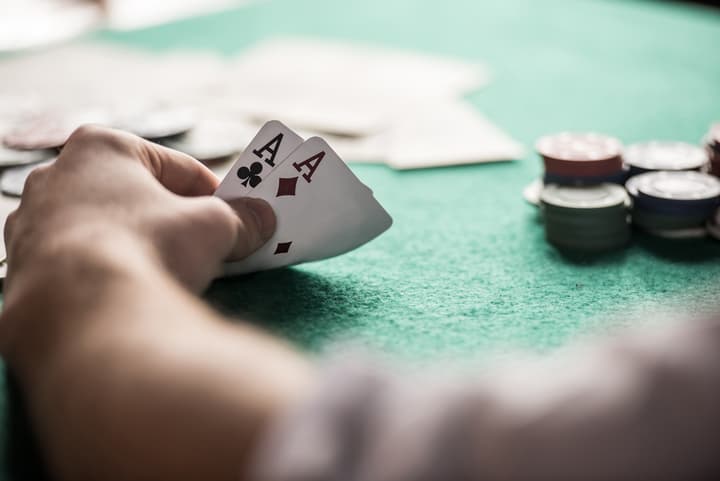Poker Odds – Know the Numbers in Your Games

13 minutes
A game of Texas Holdem may seem very simple when you watch the pros play it on TV. After all, it’s just gambling, right? Not quite!
In fact, there is quite a bit of skill involved in playing poker.
If you are new to poker or you have been playing for a while but don’t quite understand the game too well yet, it is time you learned one of the most basic poker concepts, and that is the poker odds.
Since poker is a game played with a 52 card deck, the probability of being dealt certain cards or certain cards coming on the flop, turn, or river can be calculated quite effectively.
The chance of any specific occurrence in poker can be broken down into various poker odds and expressed in percentage numbers.
In this article, I am going to show you how to calculate your poker hand odds and how to apply these calculations in-game. Once you have learned this, you will start playing better poker at once.
Poker Odds for Preflop Hands

The first time that poker odds come into play in poker is before the flop. You are sitting at the table and have not had your cards dealt yet, and you may be wondering when are those pocket aces finally coming your way?!
Preflop Hand Combinations Odds
If you don’t know your preflop poker odds, I have decided to break them down for you, showing how often you can expect to receive one combination or another.
| Poker Hand | Odds | Percentage |
| Pocket Aces (AA) | 220:1 | 0.45% |
| AK Suited | 331:1 | 0.30% |
| AK Offsuit | 81.9:1 | 1.2% |
| Pair Tens or Higher | 43.2:1 | 2.26% |
| Suited Broadway Cards | 32.2:1 | 3.02% |
| Suited Connectors | 24.5:1 | 3.92% |
| Pocket Pair | 16:1 | 5.88% |
| Connected Cards | 5.38:1 | 15.7% |
| Offsuite disconnected cards | 0.87:1 | 53.4% |
This chart of preflop poker hand odds is not really too important in the actual game, as you get dealt the cards you get dealt regardless of any charts.
However, if you are playing in a game and thinking it’s been a long time since you have a big hand, you may want to refer back to this chart and think about how hard it is to actually get dealt certain cards.
The table tells us that you only get dealt pocket aces once in 221 hands, and the same goes for any other pocket pair. This means, on average, you should get dealt hands like AA, KK, and QQ once in 221 hands each.
We can also see that getting dealt AK suited is more difficult than getting pocket aces since there are only four combinations of AK suited and six combinations of pocket aces.
The truth is that over 50% of all hands dealt are disjointed, not suited, and contain at least one card lower than a nine.
This means that your patience must be exercised, especially at full ring tables, as one of the players is likely to be holding a good hand when you are holding trash.
Hopefully, knowing these numbers will let you avoid an emotional breakdown when you think you are not getting any playable poker hands combinations and see things as it is.
Calculating Poker Odds Postflop

Even though the preflop poker odds I just explained are important to know, they are less relevant to actual gameplay than the odds you need to calculate on the flop and later rounds.
Once the flop is dealt, you finally have access to five cards in total, with three community cards out there for everyone to see.
On the flop, you can start assessing your hand compared to other players’ perceived ranges.
In many cases, it becomes quite clear that you need to improve your hand in order to win.
If your hand is not good enough on the flop or you would like to see it improve further, calculating poker odds is the way to know what kind of chances you have of this happening.
Before we can start calculating odds, we must explain the concept of outs in poker. Since we calculate our odds based on the number of cards left in the deck, let’s talk about outs first.
Outs in Poker
Outs are any cards that can help improve your holding into a better poker hand.
For example, if you are trying to make a spade flush and have four spades on the flop, you would need one more spade card in order to have a flush.
- There are 13 spades out of the 52 cards in a poker deck.
- Since we already have 2 in our hand and 2 on the flop, that leaves a total of 9 spades in the deck.
- This means we have 9 outs to make our flush.
The same logic can be applied for all other types of drawing hands or even a made hand looking to improve further.
For instance, if we are holding AK and there is an ace on the board, we can think about 2 more aces and 3 more kings in the deck, each ready to improve our hand on the turn or river, for a total of 5 outs.
Here are some common situations with a number of outs to make the learning process easier.

You can include various cards in your calculation based on what you believe your opponent has and what kind of a hand you need to make to beat them.
In some extreme cases, you can also count good bluff cards as your outs since these cards coming on the turn or river may let you win the hand without actually having the goods.
Using Outs to Calculate Odds
Now that you know what outs are, let’s talk about how to calculate poker hand odds. The actual formula for calculating odds based on outs is relatively complicated and hard to do in-game, but there is a better way.
Using what we call “the rule of two” and “the rule of four,” you can easily calculate your approximate odds of making your hand in just seconds.
These calculations are not spot on, but this does not mean they are not useful. In fact, these numbers come so close to the true calculations that they are widely used even by the best poker players.
Rules of two and four can be simply explained and used like this:
- Multiply all outs by 2 if waiting for the turn card to come
- Multiply all outs by 2 if waiting for the river card to come
- Multiply all outs by 4 if waiting for both turn and river to come
For example, if you are holding a flush draw and have 9 outs on the flop, you could use these rules to calculate your odds on the spot.
- The odds of the turn card making your flush would be 9*2 = 18%.
- The odds of the river card making your flush would be 9*2 = 18%.
- In total, your odds to make the flush would be 9*4 = 36%.
Keep in mind that you should always be calculating the odds for the next street only when facing a bet. This is because you may face another bet on the turn, so your river odds may not come into play.
The only time this is an exception is when your opponent moves all-in on the flop, in which case you know you will get to see both the turn and the river if you make the call.
Applying the Odds In-Game: Pot Odds Explained

Now that we know the Texas Hold’em odds and how to calculate them, it’s time to think about how we can apply them at the table. Of course, tools like Poker Tracker 4 can help you with this, but you still need to understand the logic behind the math.
After all, what good does it do us to know what the chances are of our card coming? Well, it actually does us a lot of good.
By knowing your odds of making the hand, you can correctly decide whether to call your opponents’ bets or fold your cards into the muck.
To make this decision, we must compare our true odds to the pot odds and calculate if making a call is a profitable decision.
Before we can do that, we must learn about pot odds and understand how they actually work.
What Are Pot Odds?
Pot odds are another concept we need to understand to make odds calculations have any meaning.
In the simplest of terms, pot odds are the overall pot ratio and the bet that you are facing at one particular moment.
For instance, let us assume you are playing a $1/2 game at our local casino.
- The flop has been dealt with a total of $30 in the pot, and your opponent makes a half-pot bet for $15.
- The overall pot is now $45, and you need to call $15 to see the next card.
- This makes the overall pot odds 3:1, and that’s very important.
Based on knowing the pot odds, we can calculate the true odds we need to make calling this bet a profitable decision.
Using Pot Odds to Make Your Decision
Now that we know what the pot odds are and know what hand we are holding, we can start making some comparisons.
In the example above, our opponent has made a $15 bet, and we are now facing pot odds of 3:1.
Let us assume we are holding a flush draw with 9 outs and 36% overall equity. Of course, we will only realize 18% of that equity on the turn if we call this bet.
When facing pot odds of 3:1, we would need to win the pot once out of four times to make this call a profitable decision.
So are we going to win it once out of four times?
Well, this is more complicated than it seems at first. If our opponent was all in for $15 on the flop, we would have an easy call. We have 36% equity in the pot with two cards to come and only need to win one out of four times (25%).
However, since our opponent has more money behind, he may decide to bet the turn again. This means we will only get to realize 18% of the equity we have, while the other 18% may be subject to more bets.
Yet, the call with a flush draw on this flop is an easy one.
We have 18% equity to make our hand on the turn, and there is more betting to be done. Once we make our hand, our opponent may decide to make or call further bets, and this brings us to the concept of implied odds.
Implied Odds: Getting Paid When You Get There

If we were playing poker where all betting is finished on the flop, true odds and pot odds would be all we would need. That would also make for quite a boring game.
Thankfully, there is more betting to be done on later streets at all times, which means there is money to be won when we make our big hands.
After all, we are rarely looking to make a straight or a flush simply to win what’s already in the pot.
Instead, we are looking to win big pots with these powerful hands.
The idea of implied odds refers to the odds we stand to get once we do make our hand. Let us refer to our flush draw example from above again.
We only have an 18% chance of making our hand on the turn, and we are facing a $15 bet. Calling this bet would not be profitable if only the turn card was in play and there was no more betting.
However, let us assume we make our flush on the turn, and our 18% turns into a reality.
We are now in the driver’s seat. If our opponent bets, we can set the trap and just call again. If they check, we can start betting ourselves.
While our opponent only bet $15 on the flop, we can now start making bigger bets with our made flush. Even if we only make the flush on the river, it only takes a small bet to make our earlier calls profitable.
Players will think, often rightfully, that we may be bluffing when the flush card hits. We get to extract value from other players and justify the calls we may have made on the flop and the turn.
Keep in mind that this is exactly why value betting is very important when we do make big hands. Letting these hands go to waste can make calls with draws completely unprofitable.
True Outs and Bluffing Odds Explained

You should now know how to calculate your true odds, your pot odds, and how to think about the implied odds in your games.
But I have not yet explained what cards can be considered as outs in different scenarios, so let’s talk about that.
Some outs may be quite clear.
When holding a flush draw, all cards in that suite will be your outs. When holding a straight draw, you know exactly what cards will make your straight.
However, you should keep in mind that some other cards can be your outs as well that are not so obvious.
For example, when you hold an overcard to the board, hitting that card to make the top pair may also be enough to win the hand.
In many cases, even making a pair lower than the top pair will be enough since your opponent may also have nothing and might be bluffing on the flop.
These cards are considered as imperfect outs, and they can be added to the calculation by making an approximation.
If you think your overcard will only be good about half of the time, you can add 1.5 outs to your outs count instead of the 3 outs that actually exist for you to hit it.
Furthermore, you may want to consider bluff cards as your outs as well.
For example, if you are holding a straight draw on a board with two spades, you may want to consider what happens if a spade hits.
Your opponent may decide to stop betting, afraid that you have made a flush, so this is a good time to make bets yourself and try to take the pot away from them.
Of course, these kinds of outs are far from clear, and using them can get you into trouble sometimes. Making these assessments is exactly what makes great players better than others. If you want to kate this game seriously or even be playing poker for a living, you should spend your time mastering the math side of the game.
Common Texas Holdem Odds Examples
I have now covered all the important poker odds related topics, and if you understand how they work, you should be ready to crush some low-stakes games.
Before you leave, here is a quick poker odds chart that will let you practice and remember the main concepts you have learned in this guide.
In this table, I list several examples of bets your opponents may choose to make and explain the equity you would need to make the call. Whether you have that equity will depend on the hand you are holding, but you know how to calculate it by counting your outs and multiplying by 4.
| Bet Size | Example | Pot Odds | Equity Needed |
| Half Pot | $5 into $10 pot | 3:1 | 25% |
| 2/3 Pot | $20 into $30 pot | 5:2 | 29% |
| ¾ Pot | $15 into $20 pot | 7:3 | 30% |
| Full Pot | $20 into $20 pot | 2:1 | 33% |
| 2x Pot | $50 into $25 pot | 3:2 | 40% |
You can use the same formula and logic to calculate the equity you need in any other poker scenario. To make this calculation, add your call to the overall pot and then divide the two.
For example, when your opponent bets $5 into $10, the overall pot is $15. Add to that your $5 call, and you get a total of $20.
If you win this pot once out of four times, you have broken even on this call. This means that having 25% equity is enough to break even, as you can see in the table above.
Use the same calculation on the other examples, and you will see how I came up with the numbers in the table.
In the end, knowing poker odds is vital if you want to take this game seriously and it is one of the best Texas Holdem tips you can get.
- Poker Squeeze Play – Which Hands Make the Most Sense for Squeezing? - August 10, 2023
- How to Play Low Pocket Pairs in Texas Hold’em - July 29, 2023
- How to Make Deep Runs in MTTs More Often - July 22, 2023














